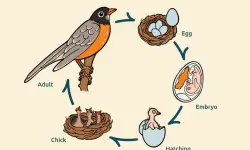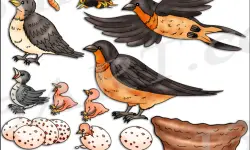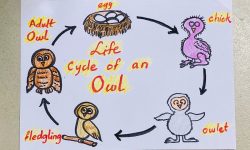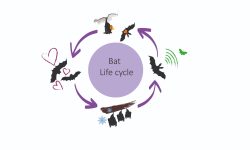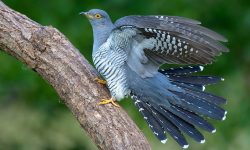The Toco Toucan (Ramphastos toco) is one of the most recognizable birds in the world, thanks to its oversized, colorful beak. But beyond its flashy appearance lies a fascinating life story—from fragile egg to agile canopy explorer. This article explores the stages of the Toco Toucan’s life cycle and the adaptations that help it thrive in the tropical forests of South America.
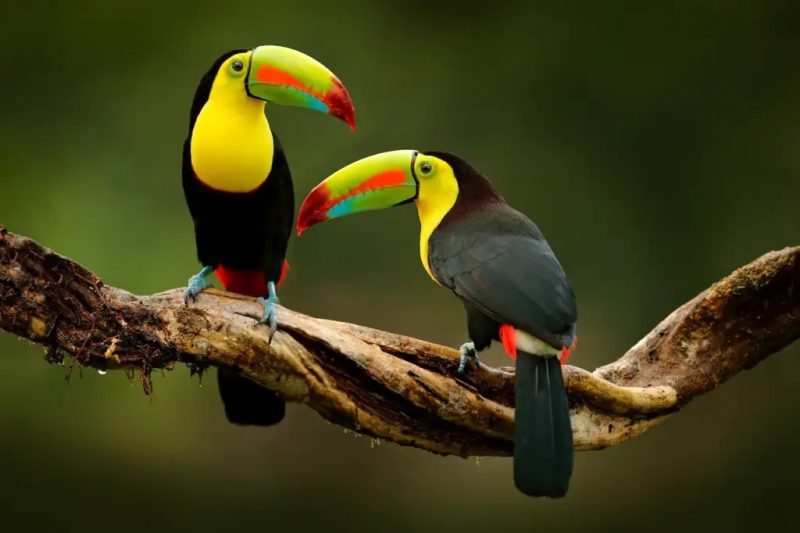
Nesting and Egg Stage
Selecting a Safe and Strategic Nesting Site
The nesting phase in the life cycle of the Toco Toucan begins with a critical decision: selecting a secure site for egg-laying. Unlike woodpeckers or parrots, Toco Toucans lack the anatomical adaptations necessary for excavating tree cavities, such as strong chisel-like beaks. Instead, they are obligate cavity nesters, depending heavily on existing hollows formed naturally through decay or abandoned by other species, particularly woodpeckers. These sites are typically located high in the canopy, offering protection from many ground-based predators and providing a vantage point for monitoring the surroundings.
Tree cavities selected by Toco Toucans are not just random shelters—they must meet specific microclimatic and spatial conditions. The entrance must be narrow enough to deter larger predators yet spacious enough inside to accommodate the adult birds and developing chicks. The interior must also retain adequate humidity and temperature to facilitate embryonic development.
Nesting tends to occur toward the end of the dry season or the onset of the wet season, a strategic timing that ensures maximum availability of fruit and invertebrates—critical food sources for both brooding adults and their eventual offspring.
Egg Morphology and Parental Incubation Behavior
Once a suitable nest site is secured, the female lays a clutch of 2 to 4 smooth, white eggs, usually spaced out over several days. The eggs are oval to slightly elliptical, with a chalky shell that is somewhat porous, allowing for gas exchange vital to the embryo’s respiration. Due to the minimal nesting material lining the cavity, the eggs rest directly on the cavity floor, making temperature regulation particularly sensitive to external fluctuations.
Both male and female toucans participate in biparental incubation, a behavior that enhances reproductive success by reducing the energetic burden on a single parent. They alternate shifts throughout the day and night, ensuring the eggs are kept at a stable temperature averaging around 37°C (98.6°F). During this period, the off-duty parent may forage nearby but often remains within calling distance to deter intruders.
Incubation lasts approximately 16 to 20 days, though this can vary slightly depending on environmental factors such as altitude, ambient temperature, and humidity. Throughout this time, vigilance is constant—the nesting pair remains alert for signs of predators, including arboreal snakes, monkeys, and raptors, which are known to prey on unguarded nests.
This stage is a pivotal moment in the life cycle of the Toco Toucan. The success of incubation sets the foundation for chick viability, and even slight disturbances—such as predation, nest competition, or extreme weather—can lead to the failure of an entire clutch. As such, the species’ highly attentive and cooperative breeding behavior reflects an evolutionary adaptation to the challenges of cavity nesting in dynamic tropical environments.
Hatching and Early Chick Development
Altricial Beginnings: Naked and Helpless Hatchlings
Following the approximately 16 to 20 days of incubation, Toco Toucan chicks emerge into the world in an altricial state—a biological term referring to hatchlings that are underdeveloped, blind, featherless, and completely incapable of independent survival. At hatching, they weigh only a few grams, and their skin appears translucent and pink, lacking insulation and camouflage. Their eyes remain sealed shut, and their beaks—so iconic in adults—are short, soft, and pale, showing no hint of the vibrant coloration they will later acquire.
This vulnerable stage demands complete protection, and the darkness and insulation of the tree cavity provide a stable microclimate, minimizing exposure to predators, rainfall, and temperature extremes. Because they cannot thermoregulate, the presence of brooding parents in the cavity during the first days is crucial to maintaining the chicks’ internal body temperature.
Nutritional Demands and Parental Investment
Toco Toucans are attentive and responsive caregivers, with both male and female sharing in the feeding and protection of their young. Multiple times a day, each parent regurgitates partially digested food, which may include a mix of soft fruits, small insects, spiders, and other arthropods, directly into the chicks’ gaping mouths. This diet is rich in sugars, fibers, proteins, and essential micronutrients, supporting both structural development and immune function.
During the first two weeks, growth is rapid. The chicks begin to develop pinfeathers—small, keratin-filled sheaths that will eventually open into full plumage. Around the third week, their eyes start to open, and the first signs of pigmentation appear on the bill. The bill itself begins to elongate noticeably during the fourth and fifth weeks, although it will not reach full adult proportions or brilliance until several months after fledging.
By six to eight weeks post-hatch, the chicks reach a developmental milestone: fledging. At this point, they have acquired sufficient wing strength and coordination to leave the nest cavity and explore the surrounding canopy. However, fledging is not synonymous with independence. Juvenile toucans remain under parental care for several more weeks, during which they learn essential survival skills—locating food, navigating tree branches, and avoiding predators. The adults continue to supplement their diet with regurgitated food during this transitional period.
This stage of early development is energetically demanding and represents a critical bottleneck in toucan reproductive success. High predation rates, competition for nesting cavities, and food scarcity can severely impact chick survival. Nonetheless, when conditions are favorable and parental care is robust, the Toco Toucan’s combination of prolonged care and adaptive feeding strategies sets the stage for the next chapter in the young bird’s journey—exploring the rainforest canopy as an emerging forager.
Fledging and Learning to Navigate the Canopy
First Flights and Developing Coordination
At approximately 7 to 9 weeks of age, young Toco Toucans undergo one of the most significant transitions of their life cycle: fledging. After weeks of growing under the protection of the nesting cavity, they finally leave the nest and take to the air, though their early attempts at flight are often unsteady and awkward. These first flights are usually short, low glides between branches in the forest understory, as the juveniles test their wing strength, balance, and spatial awareness.
One might expect their large bill to hinder these efforts, but the Toco Toucan’s beak is ingeniously engineered. Despite its size—making up about one-third of the bird’s total length—it is surprisingly light, composed of a spongy, hollow structure supported by keratin and reinforced with internal struts. This design minimizes the beak’s weight, allowing fledglings to develop coordination without being thrown off balance. Over successive days, their wingbeats become more confident, their landings more precise, and their flight range extends higher into the vertical space of the canopy.
Mastering the Canopy: From Dependence to Independence
The period following fledging is not one of instant autonomy. Juvenile toucans continue to rely on their parents for nourishment and guidance, while gradually honing the skills required to survive in the complex and competitive environment of the rainforest. This stage can last several weeks, during which the fledglings accompany adults on foraging trips and observe experienced behavior patterns.
Learning to forage is a multi-layered process. Toco Toucans must distinguish between edible and inedible fruits, recognize the ripeness of berries, and develop the agility needed to pluck food from high, unstable branches. They also learn how to catch and handle small animal prey, such as insects, lizards, or nestling birds—a skill that supplements their mostly frugivorous diet with critical proteins.
Equally important is learning predator avoidance. Juveniles are especially vulnerable to tree-climbing snakes, raptors, and carnivorous mammals. By mimicking adult alarm calls and adopting evasive maneuvers, young toucans begin to integrate into the acoustic and visual language of rainforest survival.
These early weeks outside the nest shape the bird’s cognitive and physical capabilities. Spatial memory, vocal communication, and social hierarchy recognition all develop rapidly during this stage. As juveniles transition from following to leading, they gradually wean off parental support and begin to establish their own feeding routes and roosting preferences within the canopy.
The fledging period, though brief in terms of months, plays an outsized role in the eventual success of each toucan. It is during this time that the foundations of adult behavior are formed—a process of learning, adapting, and maturing amid the towering complexity of the tropical forest.
Maturity and Adult Life
Reaching Sexual Maturity and Courtship Behavior
Toco Toucans (Ramphastos toco) typically attain sexual maturity between 2 and 4 years of age, a point at which their vibrant plumage, fully developed beak, and social behavior signal reproductive readiness. Maturity is not solely a physical milestone; it also marks the acquisition of complex social and cognitive behaviors essential for breeding success.
During the breeding season, adult toucans engage in elaborate courtship displays that strengthen pair bonds and synchronize reproductive timing. One of the most iconic behaviors is mutual beak-touching, where individuals gently clack or tap their oversized bills together in a rhythmic display. This behavior, often accompanied by soft vocalizations and head movements, serves both as a tactile communication method and a non-aggressive test of compatibility.
Another key behavior is food sharing, in which one toucan offers fruit or insects to the other. This symbolic “gift” may reinforce bonding and signal the provider’s ability to support a future mate and offspring. Once a strong pair bond is established, the birds will seek a suitable cavity to begin nesting, often returning to traditional sites used in previous years.
Adult Roles in the Rainforest Ecosystem
Beyond reproduction, adult Toco Toucans play important ecological roles as seed dispersers and pollinators. Their diet consists primarily of fruits, and they frequently travel long distances across the forest canopy. By consuming fruit and excreting seeds elsewhere, toucans help maintain plant diversity and forest regeneration. Their presence is thus vital to the health of the ecosystem, especially in fragmented habitats where natural seed dispersers are declining.
Their loud, croaking calls can be heard echoing through the treetops, serving not only as territorial markers but also as communication tools within small groups. Adult toucans are often seen in loose social flocks, although during breeding season, pairs become more territorial and secretive.
Life Expectancy: Wild vs. Captivity
In their native habitat across South American rainforests and savannas, Toco Toucans typically live between 10 and 15 years. This lifespan is influenced by a range of ecological pressures, including predation, habitat loss, food scarcity, and disease. Raptors, snakes, and human activities such as logging and the illegal pet trade all pose serious threats to survival.
In contrast, toucans kept in zoos or aviaries with professional care often live well beyond their wild counterparts. In captivity, some individuals have been documented to live up to 20–25 years, thanks to balanced diets, routine veterinary care, protection from predators, and a stable environment. However, longevity in captivity also depends on mental stimulation and adequate space, as these intelligent birds are prone to stress if confined or understimulated.
Whether in the rainforest or in human care, the adult phase of the Toco Toucan’s life is characterized by high cognitive function, complex behaviors, and a continued reliance on its iconic beak—not only as a feeding tool, but as a key instrument in social and reproductive success.
Ecological Role and Social Behavior
The Toco Toucan as a Keystone Seed Disperser
The Toco Toucan (Ramphastos toco) serves as a keystone species in its ecosystem through its critical function as a seed disperser. Feeding primarily on a diverse range of tropical fruits, the toucan consumes the fleshy pulp and subsequently excretes intact seeds at different locations, often far from the parent plant. This process, known as endozoochory, enhances seed germination success by distancing seedlings from direct competition, reducing disease transmission, and enabling colonization of disturbed or open areas.
Thanks to its oversized yet lightweight bill, the toucan can access fruits that many other frugivores cannot reach—whether perched on slender outer branches or at awkward angles on fruiting trees. This dietary flexibility allows it to interact with a wide variety of plant species, including figs, palms, and Cecropia trees, making the toucan a vital agent for maintaining rainforest diversity and structure.
Recent ecological studies also suggest that Toco Toucans contribute disproportionately to the dispersal of large-seeded trees, which rely on birds with sufficiently wide gapes. In fragmented forests where such dispersers are in decline, the loss of toucans can lead to a cascade of ecological disruptions, ultimately impacting forest regeneration patterns.
Social Behavior and Communication in the Canopy
Despite their flamboyant appearance, Toco Toucans exhibit semi-social and non-territorial behavior, particularly outside the breeding season. They are frequently observed traveling in small flocks of 3 to 6 individuals, often composed of mated pairs, offspring, or loosely affiliated adults. This group cohesion offers several evolutionary advantages, including predator detection, cooperative foraging, and juvenile learning opportunities.
Vocal communication plays a central role in social organization. Their distinctive frog-like croaks and harsh grunting calls are amplified through the forest canopy, used not only to maintain contact but also to signal alarm or territorial presence. These vocalizations are often accompanied by bill clacking, a form of non-vocal sound production used during social interactions and mild disputes, especially among juveniles or competing mates.
Interestingly, juvenile toucans seem to learn foraging techniques and social cues by observing adults within the group. This learning period is essential for developing key survival skills, including recognizing edible fruits, avoiding predators, and mastering flight control in the complex vertical environment of the forest canopy.
The toucan’s social tendencies, combined with its ecological importance as a frugivore, underscore its role as both a biological connector and a cultural symbol of tropical ecosystems. Where toucans thrive, so too do the diverse forest communities that depend on them.
Challenges to Survival
Predators and Natural Threats
Throughout their life cycle, Toco Toucans (Ramphastos toco) face a range of natural dangers, particularly during their most vulnerable stages. Eggs and nestlings are prime targets for arboreal predators such as capuchin monkeys, snakes like boa constrictors, and opportunistic raptors. Nest cavities offer limited protection, and a single breach can result in total brood loss.
Even adults, despite their agility and canopy awareness, are not immune to predation. Their vivid plumage, though advantageous in courtship and species recognition, also makes them more conspicuous to predators in a forest environment filled with shadows and camouflage. Raptors such as hawk-eagles may ambush them mid-flight, especially during moments of distraction while foraging or feeding chicks.
In addition, the Toco Toucan is vulnerable to parasites and diseases, especially in regions with changing climate patterns that disrupt ecological balances and increase pathogen spread. Nest competition with other cavity-nesting birds or mammals may also reduce available breeding sites in fragmented habitats.
Habitat Loss and Human Impact
The greatest threat to the survival of the Toco Toucan stems not from natural predators but from human activity. Widespread deforestation in the Amazon Basin, the Cerrado biome, and bordering ecosystems continues to erode the dense, mature forest cover that toucans rely on for nesting, feeding, and shelter. Logging, agricultural expansion, cattle ranching, and road development fragment habitats, reducing tree diversity and canopy continuity, which are crucial for fruit-bearing trees and nesting cavities.
The illegal pet trade poses an additional man-made hazard. Due to their striking appearance and curiosity-driven behavior, Toco Toucans are often targeted for capture and sale as exotic pets. This extraction not only reduces wild population numbers but also disrupts social structures, as captured birds are often juveniles taken directly from nests.
As climate change accelerates, shifting rainfall patterns and increasing temperatures could further alter fruiting cycles and insect availability, indirectly stressing toucan populations by reducing food security and breeding success.
Without conservation interventions, these compounded pressures may gradually reduce the toucan’s range and reproductive viability, especially in isolated forest patches. Protecting their habitat and reducing human exploitation will be key to securing their future.
Conservation and Future Outlook
Status in the Wild
Despite the increasing pressure on South American forests, the Toco Toucan (Ramphastos toco) remains classified as a species of Least Concern by the International Union for Conservation of Nature (IUCN). This status is largely due to its broad geographic range—spanning across Brazil, northern Argentina, Paraguay, Bolivia, and parts of Peru—and its remarkable adaptability to fragmented landscapes, secondary forests, and even agricultural areas.
However, this overall stability masks a more complex local reality. In regions where deforestation is intense and unregulated, particularly in the Amazon-Cerrado transition zone, localized population declines have been recorded. These areas experience diminished food availability, loss of suitable nesting trees, and increased human-wildlife conflict, all of which can erode the reproductive success and long-term viability of Toco Toucan populations.
Protecting the Next Generation
To ensure the future of this iconic bird, proactive conservation strategies are essential. Protecting large tracts of old-growth rainforest remains the most effective long-term solution. These mature forests provide the full spectrum of ecological resources toucans need—from towering nest cavities to a diverse array of fruiting trees and insect prey.
Efforts to curb the illegal wildlife trade must also be strengthened. Public education campaigns, enforcement of anti-trafficking laws, and improved surveillance at wildlife checkpoints can reduce the capture and sale of toucans as exotic pets. Rehabilitated individuals, when possible, should be reintroduced into safe, monitored habitats.
Involving local communities in toucan conservation is equally crucial. Environmental education programs that highlight the seed-dispersing role of toucans can foster appreciation for their ecological importance. Ecotourism initiatives that promote toucan-watching in their natural habitat also provide economic incentives for forest preservation.
Climate change mitigation, reforestation projects, and increased scientific monitoring will further bolster the species’ chances of long-term survival. While the Toco Toucan is not currently endangered, preserving its habitat today ensures that future generations can witness this brilliant canopy king in flight—a living symbol of the rainforest’s resilience.
Conclusion: From Egg to Icon
The life cycle of the Toco Toucan reveals the complex journey behind one of the rainforest’s most charismatic birds. From its fragile beginnings as a nearly invisible egg to its full glory gliding through the treetops, each stage of life is shaped by biological precision and ecological harmony. Protecting this species means preserving not only a bird—but a crucial thread in the fabric of tropical biodiversity.

